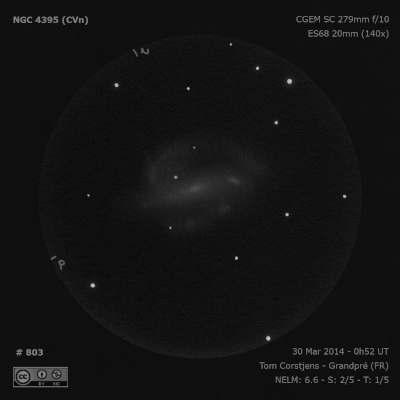
William Herschel discovered NGC 4395 = H V-29.1 = h1252 on 2 Jan 1786 (sweep 508) and recorded "eF, vL, vlbM, resolvable, about 10' long and 8 or 9' broad." JH made two observations, logging on 29 Apr 1827, "two nebulae running into one another; both eF, vL, the f rather the brighter. Place that of the preceding." Dreyer catalogued the two components as NGC 4395 = V 29.1 and NGC 4401 = V 29.2. On a second observation, JH wrote "vL; extremely ill defined, may perhaps be 10' l, 3' br; pslbM to an irregular centre. On closer inspection bicentral; pos of the nuclei 30° np; dist 2'."
This galaxy was viewed on three occasions at Birr Castle by Bindon Stoney, who recorded "a cluster of nebulae found" on 13 Apr 1850 and "there are 4 nebulae. The 3 f ones seem to be inv in a mass of F neby." Based on these observations, Dreyer included two additional entries: NGC 4399 and NGC 4400. The sketch of these condensations match up well with my own observations with a 17.5" and can be identified on the POSS.
300/350mm - 13.1" (4/12/86): at 62x appears very large, diffuse, slightly elongated glow, broad very weak concentration.
400/500mm - 17.5" (5/15/99): this chaotic galaxy is dominated by several bright HII regions. At 100x, the large low surface brightness glow is clearly clumpy with a couple of faint knots evident on the east side of the haze. At 220x, the glow of the galaxy is more difficult to view and several nonstellar knots and a couple of very faint superimposed stars are more prominent. The brightest HII region is NGC 4401 located 2' SE of the core, ~25" in size, with a second smaller 15" knot (NGC 4400) close south. The core of the galaxy appears as an ill-defined, low surface brightness glow, larger than the individual HII knots. A mag 14.5 star is superimposed NE of the core. On the SW side of the core is a third difficult knot, about 15" in diameter (NGC 4399) requiring averted vision to confirm. Member of the M94 Group (CVn I Cloud).
17.5" faint, very large, extremely low surface brightness, must use low magnification to view. Three knots are involved (one of these observed "knots" may be the core) within a very diffuse glow. The brightest knot NGC 4401) is at the SE end about 2' SE of center with(NGC 4400 close SSW of NGC 4401. A mag 14.5 star is at the north end. Also see description for(NGC 4399.
Notes by Steve Gottlieb